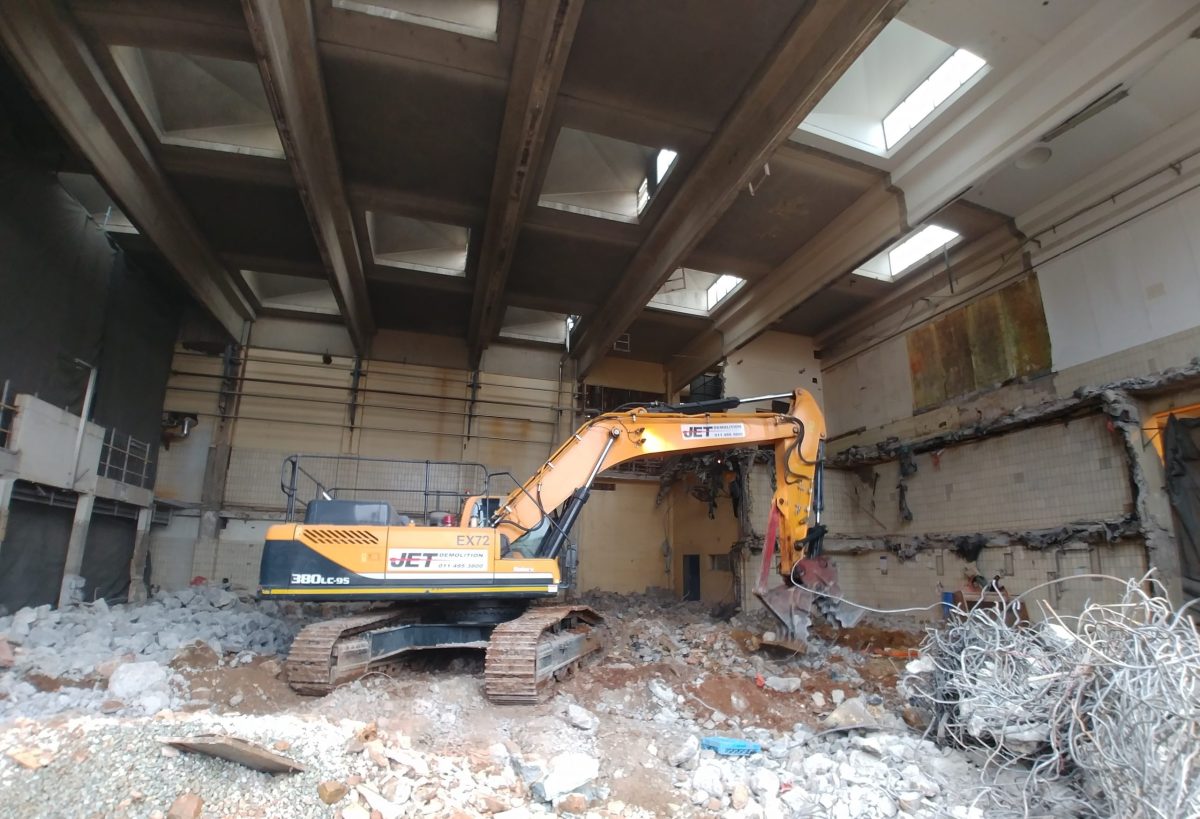
Supplied by Jet Demolition
A sustainable built environment extends well beyond deconstruction. It has to consider the risk profile of deconstruction versus demolition, as well as the salvage value of equipment versus the recycling value thereof, in order to make informed and practical decisions.
Deconstruction potential in the urban environment is limited due to the fact that most urban structures are brick-and-concrete hybrid structures. There is a much greater potential for re-using and repurposing existing structures if well-maintained, of for recycling and repurposing demolished materials in future works. In addition, site footprints can often be used much more beneficially.
“Deconstruction relates to the total or partial removal of structures or equipment, with the main focus on beneficial reuse, whereas demolition refers mainly to the removal of structures or equipment, with a focus on recycling of the resulting materials,” explains Jet Demolition Contracts Manager Kate Bester (NDip Civil Engineering – PMP).
Generally speaking, deconstruction activities are significantly more labour intensive and take longer to complete. The deconstruction process also generally has a significantly increased risk profile and typically requires cranes and lifting machines for extended periods. Demolition, on the other hand, has the potential to be much more mechanised and quicker, and can potentially have a significantly improved risk profile. Demolition is often also more cost-effective due to the reduced requirements for extensive crane rental.
It is tempting to opt for a salvage and deconstruction option, with the end goal being the potential resale of structures and equipment. “The reality is that projects of this nature have the potential to be extremely drawn out, as the work is typically much more susceptible to weather conditions and other factors beyond the control of the contractor or client,” points out Bester.
For example, lifting and cranage activities can be suspended under windy or rainy conditions, but the contractor is still liable to pay. In addition, the labour-intensive nature of deconstruction works requires significantly more people on site at any given time, working with hand tools. Although the potential exists to sell salvaged equipment and structures, it is also a minefield of liability. Purchasers generally prefer acquiring equipment with some form of guarantee or service plan, locking the seller into extended warranty and service agreements.
Demolition, on the other hand, eliminates many of these obstacles. Progressive and experienced demolition contractors such as Jet Demolition generally pursue mechanical demolition methods, reducing the risk of worker-structure interface. These approaches use specialised demolition equipment to reduce structures to ground. All resulting materials can then be recycled where appropriate which, in turn, may result in an alternative revenue stream for the client, without the risk of long terms and extended warranties.
In considering the practicalities associated with deconstruction, buildings and structures need to be assessed on an individual basis for their suitability for dismantling. More often than not, dismantling should be reserved for well-maintained, low-risk steel structures, or for equipment in good working condition that can easily be salvaged, reinstalled and recommissioned.
Looking at recycling, there are multiple opportunities available that are not necessarily always considered in urban revitalisation projects. Through judicious planning and implementing suitable methods to prevent cross-contamination between waste streams, it is possible to segregate and prepare different types of material for recycling and beneficial re-use. These include basic materials like concrete and brick that can potentially be crushed and reused on-site, or inert rubble used to backfill sinkholes. “It is critical that clients and contractors work together to explore options that are practical and viable and that can contribute to a circular economy,” stresses Bester.
“The South African economy is generally challenging to begin with, and pursuing recycling opportunities is not always the most financially viable option for clients to consider. As such, it is difficult to fully explore all recycling opportunities that may exist within a project. As the industry evolves, we hope to see an increased participation and requirement for recycling,” she concludes.
“There are multiple opportunities available that are not necessarily always considered in urban revitalisation projects.”
– Kate Bester
About Jet Demolition
Jet Demolition has been undertaking industrial demolition works since 1994, and is the leading, largest, and most technically-advanced demolition company in Africa. It offers in-house, full-range demolition services, including advanced mechanical solutions and controlled implosions. It actively pursues ongoing development of skills and equipment suited to the changing needs of the industry.
Jet Demolition is a technically-based company, with various staff members holding MSc, BSc, and BTech Degrees, as well as National Diplomas, in various engineering fields. This expertise gives it the technical foundation to successfully engineer solutions for large and complex demolition projects, and furthermore fuels its drive to deliver quality projects safely. Jet Demolition strives to offer its clients innovative and technical solutions to demanding demolition challenges.

